For today’s blog post, I thought it would be worthwhile and prudent to review some of our positions and policies for anyone who may be new to our content.
First, I hope that everyone takes the time to find out why we exist, how we do what we do, and why we do it that way. The quickest way to familiarize yourself is to visit the Mission, Vision and Goals page on our organization’s website.
You’ll quickly see that we’re extremely opposed to practice of keeping nonhuman primates in captivity. Unfortunately, many chimpanzees were taken from the forests of Africa years ago and have been bred and behaviorally conditioned for use in research and entertainment. The majority of these individuals were deprived of the irreplaceable maternal bonds and complex social networks that free-living chimpanzees depend on for survival, essentially rendering the entire captive population incapable of a reintroduction into the wild.
As a response to these past injustices, the sanctuary provides a permanent retirement home for these individuals where they are free from further exploitation and can have some degree of self-determination.

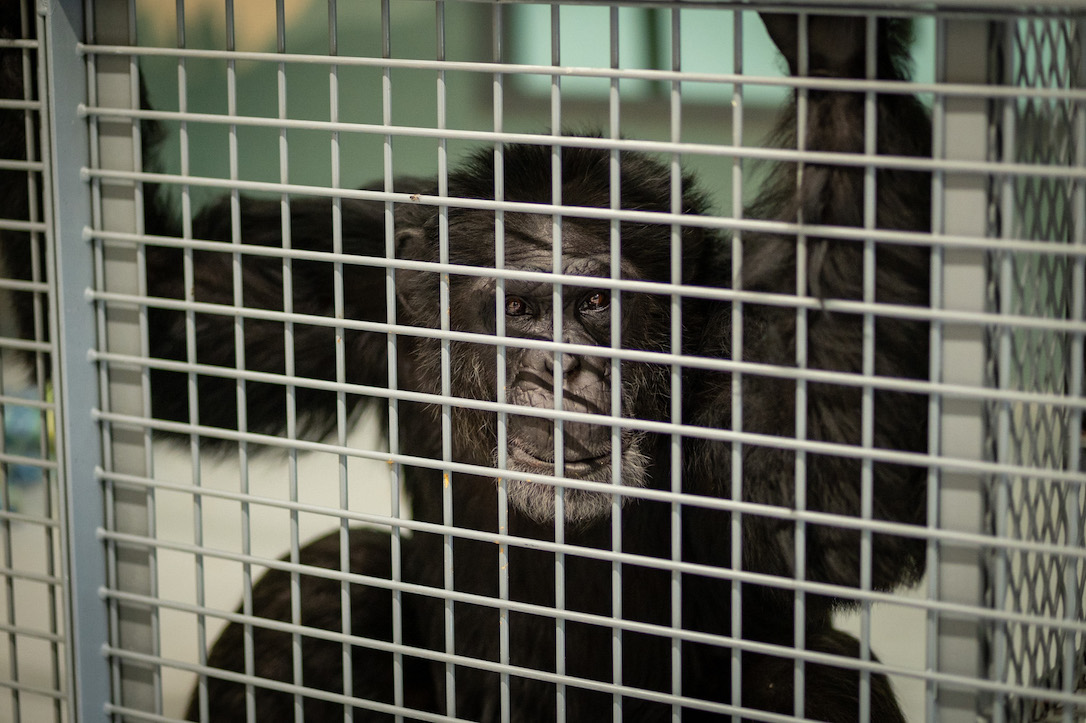
This protection from harm does not, however, come with absolute freedom from captivity. Each group of chimps has regular access to several different enclosures, but they must stay within these areas for their own security (and for human safety). Chimpanzees are not a domesticated species and the individuals we care for are not tame, so it would be irresponsible and dangerous to let them out of their enclosures to interact with humans in any capacity. Likewise, we never enter an enclosure occupied by chimpanzees; Before staff can unlock a space for cleaning or repairs, multiple trained personnel must confirm that all the chimps are accounted for elsewhere and that all the barriers between the areas are secure.


If a staff member or experienced volunteer wants to have a social interaction with a chimpanzee (e.g., playing, grooming, serving food), the human must follow our protected contact protocols which minimize the risk of physical injury. This policy also requires us to wear appropriate protective equipment, such as masks and gloves, in order to protect the chimps from any respiratory illnesses that we may be carrying.
When we share photographs or videos of humans and chimpanzees engaging in these activities, we add a disclaimer that provides key contextual details and reiterates our philosophy on captivity. Otherwise, we’d risk spreading the harmful myth that chimps can be safely handled.


Similarly, imagery of nonhuman primates situated in artificial environments (or provisioned with similarly anthropogenic objects) may cause people to wrongly believe that they are meant to be in proximity to humans. As advocates for these individuals and their species, this puts us in an awkward place. Are we better serving the chimpanzees if we portray them as they should be or as they currently are?

When sharing any content online, our team also has to consider the aesthetics of our facility and how it may be perceived. While we prioritize the design and regular enrichment of these enclosures in ways that maximize their suitability for the chimpanzees, they still have some unmistakable hallmarks of captivity: cement floors, industrial architecture, steel caging, and giant padlocks. For this reason, we often belabor the fact that the chimps have access to various indoor and outdoor areas throughout the day (except for the brief periods when we’re cleaning each of those spaces) but often choose to hang out inside regardless of the other options made available to them.
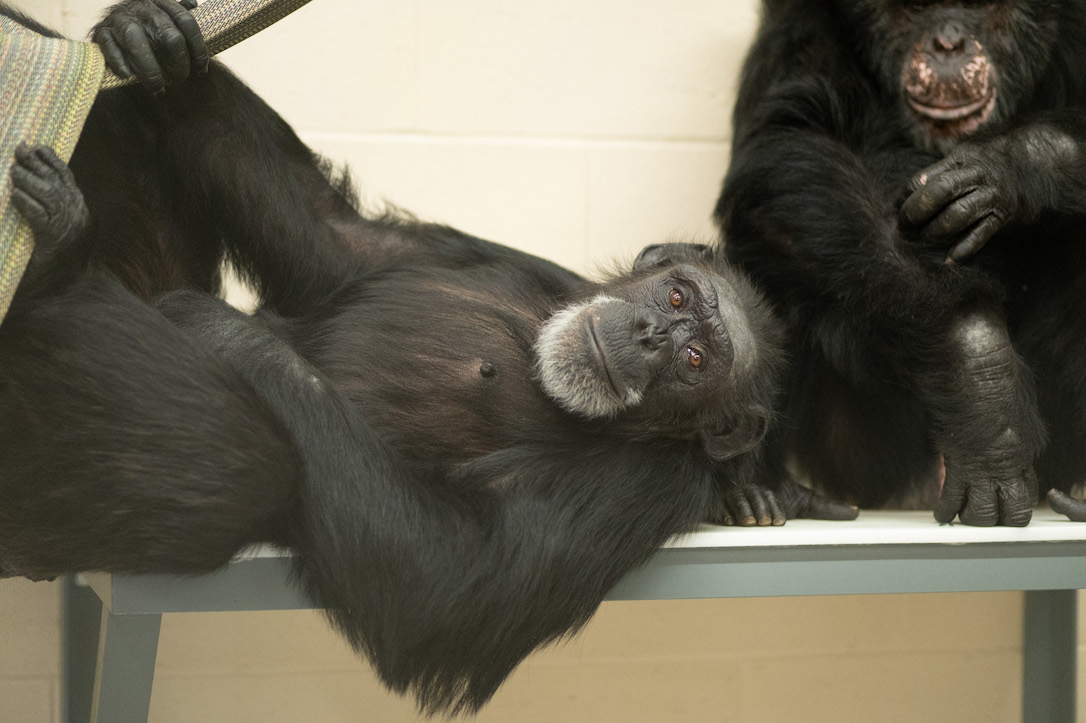
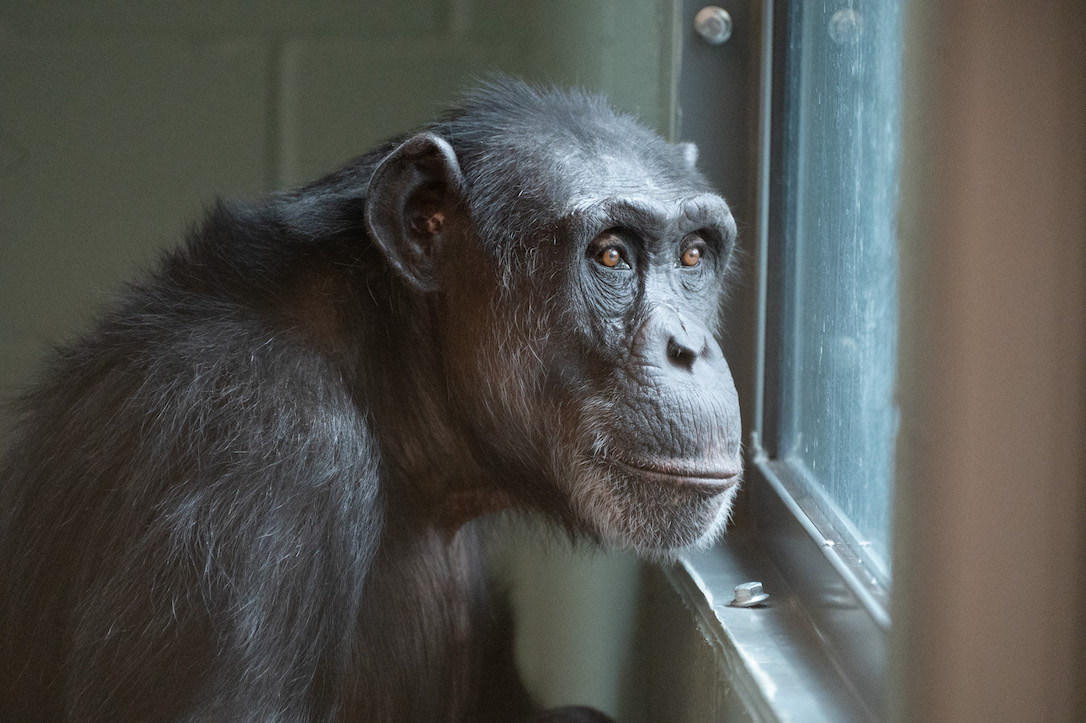
The facility’s largest (and most “natural”) enclosure is Young’s Hill, a two-acre meadow furnished with wooden climbing structures and surrounded by a perimeter of electrified fences. The chimps frequently explore and patrol this space and we look forward to having another outdoor area for additional group of chimps to use simultaneously. Even so, the chimpanzees who reside at the sanctuary choose to spend only a small fraction of their time out there (despite the unique opportunities that such a habitat gives them). Instead, the chimps generally prefer to socialize and lounge in the semi-enclosed “greenhouses” throughout the day and make their nests in the elevated portions of the climate-controlled “front rooms” and “playrooms” each night. Some even choose to sleep on the heated cement floors.
The truth is that these chimps have lived most of their lives in artificial spaces like these. Apparently, they feel more comfortable in them.
Who would we be if we forced them to do anything different?


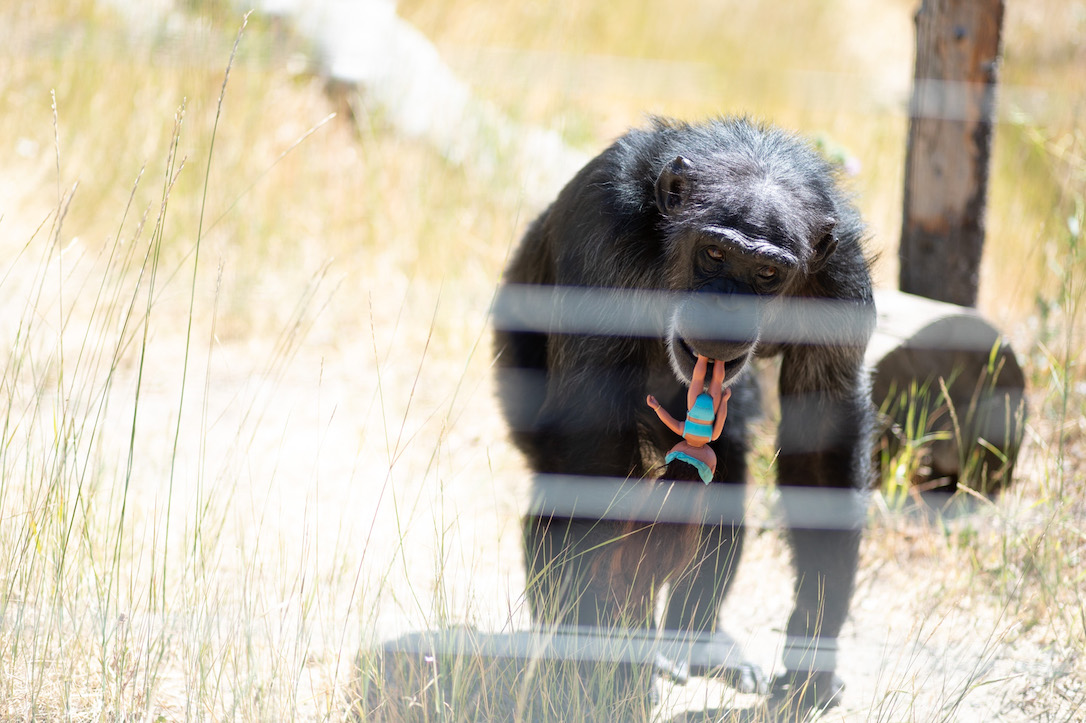
Last year, Diana wrote some words that, in my opinion, say it best.
We’ll continue to blur the fencing out of some photos and put the cameras up to the caging for an unobstructed view, but it’s not because we want you to forget that it’s there; it’s so you can fully see the unique and wonderful chimpanzees who are choosing to do whatever they are doing in the moment when the camera shutter closes.
I compiled an assorted reading list for anyone who wishes to read more about these nuanced issues (and hopefully get some perspectives besides my own)!
From our website:
CSNW Blog: “Why are the Chimps in Cages?” (by Diana, 2015)
CSNW Blog: “The Tough Questions” (by Me, 2020)
CSNW Blog: “Caging is OK” (by Diana, 2020)
From other sources:
Study: Impact of Visual Context on Public Perceptions of Non-Human Primate Performers
IUCN’s Best Practice Guidelines for Responsible Images of Nonhuman Primates
North American Primate Sanctuary Alliance’s Position Statements
Thank you all for caring so much about chimpanzees!
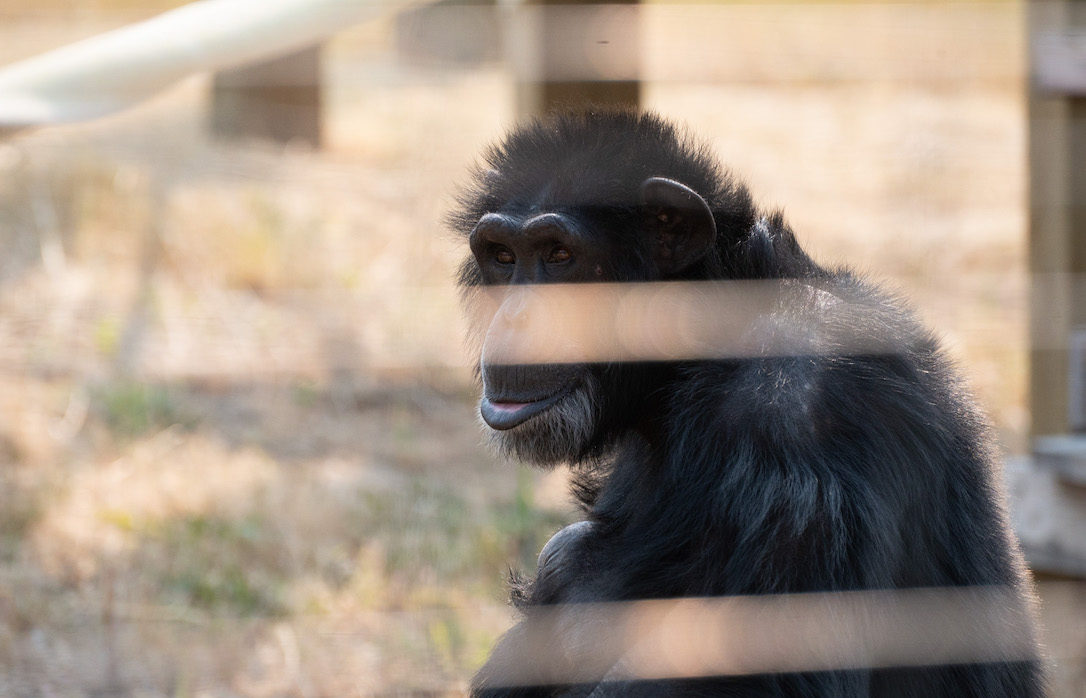



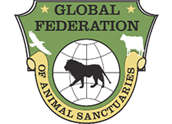
Thank you, Anthony, for providing this (sadly) necessary reminder about the chimpanzees. In a far more humane and ideal world, all of the great ape species would dwell in their natural habitats, safe from mistreatment by human primates. How I wish that the populations and natural habitats of great apes can revive and flourish. Notwithstanding the sanctuary which has been provided for 16 chimpanzees in Central Washington, their indigenous range is in Central Africa.
you have spoken before of their great strength compared to humans…….beung respectful, but careful of the chimps, is the smart way to work with them…………
Thank you, Anthony. I’ve seen some huffy comments on other sites from prople who don’t know. But I think it’s worthwhile every once in awhile for even those of us who do know to remember some of these basic facts. These chimps are so lucky! They’re well- loved, wonderfully cared for, and healthyin all regards, thanks to those of you who work so hard for them every day.:heart::heart:
im just so thankful my extended family of chimpanzee people have your staff taking FANTASTIC care of them without force. choices is what your Chimp family gets for the first time in their lives. i dont question anything about how youre running your program because the proof these beautiful, resilient and very forgiving chimpanzee people have literally aged in reverse-all thanks to yall! i do love watching them eat!
We can never be reminded enough. CHIMPS DON’T BELONG IN CAPTIVITY. But in captivity they live. This is all our doing. I am thankful everyday for the work you do to right the wrongs, to very best of your abilities, using every single tool and option available to you. As you state, CSNW offers a dignified, well deserved “permanent retirement home for these individuals where they are free from further exploitation and can have some degree of self-determination.” You do exactly that, with an incredible amount of love and compassion, humor and grace. I can never thank you enough.
Thanks for this reminder Anthony. I will explore all your links over my coffee in the morning!
Anthony, thank you for these reminders and for your descriptions. It’s with much gratitude that I’m thankful for all of the caregivers for the respect and wisdom you each bring to your work with the chimps. I’m so grateful for the staff’s expertise, caring and devotion to what’s best for the chimpanzees. And yes, it would be lovely if they were all able to roam freely and safely in Africa. Given that’s not an option, they have the best world they possibly could with the loving involvement of each of the staff. Thank you for the heartfelt devotion you each have for them! And that goes for the board and donors, too.
This comes under the heading : People suck, and ruin everything.
That said, I am so glad that sanctuary is there for these amazing individuals. We can never give back to them what people have robbed them of, but you do such a good job of trying to make them happy. and that means a lot.
Thank you:revolving_hearts:
Thank you for caring for these wonderful creatures. All wild animals wrenched from their native homes by humans deserve the care and understanding like your sanctuary.
The whole team works very hard to give the Chimps the best life in the best environment that they can. The place always looks clean and well maintained and the new areas are outstanding. I am always impressed at the work you all do! Well done CSNW team. Your commitment and dedication is appreciated and aplauded.
Thank you, Anthony, for this post. I believe all of us humans have a collective responsibility for what happened to these chimpanzees, and so we should all join together to ensure that every captive chimpanzee has some sort of justice in the form of sanctuary. The unexpected benefit has been how much joy they have brought to my life! It’s been such a pleasure to get to know Negra, and Jodi, Missy, Mave, Burrito, Rayne, Lucky, Willy B…all of them! They are amazing ambassadors for their fellow chimpanzees who remain in captivity – living caged in laboratories, as “pets,” in roadside zoos, or exploited for commercial purposes. I can’t believe this is still happening, for no reason, and no benefit to anyone. It’s horrific. I know we will all do what we can, until it ends. I’m very grateful to everyone at CSNW for giving me the opportunity to participate in this effort.
A good reminder of why sanctuary is needed. My sadness is that because of the current situation, they can no longer see your faces or kiss a real hand instead of a glove. But safety is the number one priority of course. BTW, did sweet Annie have her birthday party….I don’t think I missed a blog, but her lovely photo in the calendar reminded me.
Hi Carol, not only does the CSNW calendar provide us with 12 months of incredible photos but peek at the calendar grid and you’ll see you did not miss Annie’s birthday. Annie’s 47th takes place this Friday, September 10th! And… Merdith celebrates her 6th birthday on Thursday the 23rd!
I’ve also made a personal note on my calendar that September 20th is the 10th year anniversary of the opening of Young’s Hill. That’s worth a celebration! Ten years of foraging under the open sky. Ten years of running, climbing, and communing with nature. Ten years a patrolling the home turf! Amazing.
(Disclaimer : Dianna and J.B. will have to confirm this date but I made note of this day ages ago and I celebrate this event each year in my heart. What a gift to the Seven!)
Thanks Kathleen…..I had read it wrongly, and was too focussed on her sweet face and delicious carrot I guess!
very well said…
I so appreciate your sharing the chimps’ lives on the blog as you do and that you send your philosophical message loud and clear here.
I am a volunteer elsewhere with great apes, and the question I am asked most often is about human contact with the apes- whether the carers go into enclosures with the apes. Another is whether the apes are “nice.”
The answer is, of course, that carers never go into enclosures with them, that apes are strong and can easily hurt others entirely without meaning to. They are not pets.
People are understandably confused, then, about why they see so many photos online, including from rehabilitation programs, in which there is a very large amount of human interaction without barrier.
I have heard the term ‘thrifty’ as a value in places that provide a haven for animals who could not survive in the wild. As I understand it, thrifty refers to animals that live in interaction with each other, or not, in natural ways rather than spending their days in interactions with people.
I look so forward to these blogs everyday! Thank you for what you do and the respect and the love you give them and show them! It is not a perfect world but it is as close as it comes for these individuals given the situation! (which I might add is caused by humans!)
thank you,
That was very informative. Thank you for taking the time to put forth the real lives of the chimps and
their care givers. As with any animals tame or not tame the best information is the truth. Thank you again.
This was very thoughtfully written. Nice job, Anthony. BTW, how did Foxie get introduced to dolls?